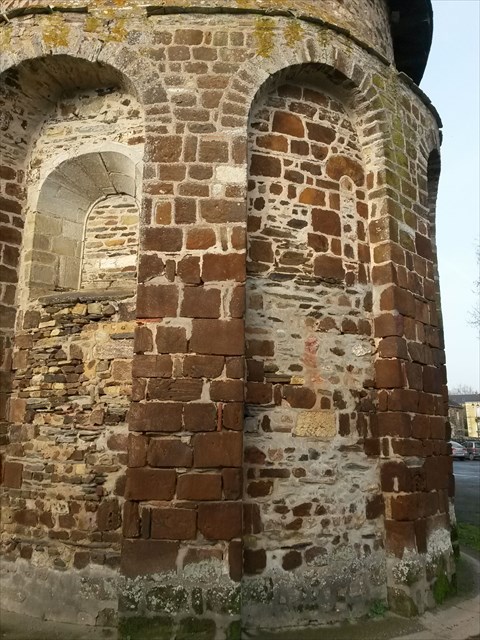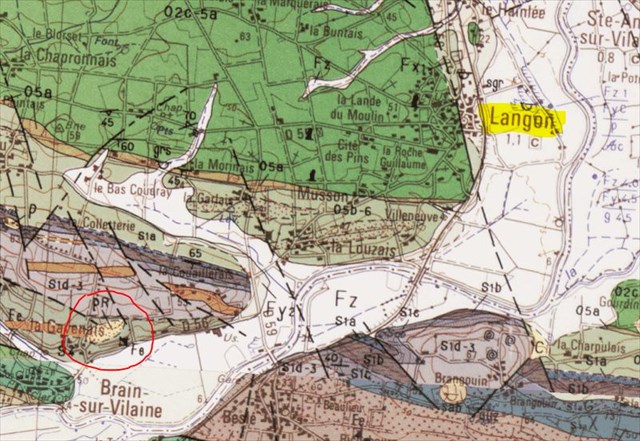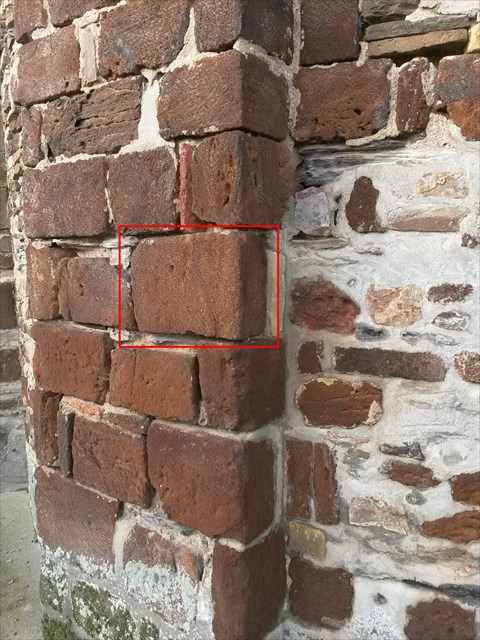
Le grès
Le grès est une roche sédimentaire détritique commune, issue de l’agrégation de grains de sable réunis par un ciment naturel. Ces grains sont majoritairement composés de silice (quartz) mais parfois aussi de grains de feldspath, de micas ou d’autres matériaux.
Formation
La cimentation des grains se fait par précipitation et cristallisation des sels dissous dans l’eau qui traverse le lit de sable. Progressivement, le sable se transforme donc en roche sédimentaire solide. On appelle ce processus la diagenèse.
Selon l’origine, la localisation, l’évolution de la diagenèse, la composition chimique des grains et du ciment, le grès va se différencier. En fonction des proportions de sable et de ciment, il sera plus ou moins friable, dense et résistant à l'érosion.
Sa couleur – ocre, rouge, jaune, orangé, brun, gris, blanc – sera fonction de la composition du ciment. Ce dernier peut être argileux, calcaire, siliceux, ferrugineux, gypseux, bitumeux, phosphaté...
Utilisation du grès
Non gélif, le grès est une excellente pierre de construction, facile à travailler et à scier. Il est utilisés dans le bâtiment, la sculpture, la fabrication de meules naturelles, la réalisation de pavés.
Il doit être choisi soigneusement en rejetant les pierres fissurées, non homogènes, contenant des trous ou des inclusions de galets.
Le grès « Roussard »
Abondant dans la Sarthe (voir GC4HWQ1), c'est un grès issu d'une sédimentation marine de sable cénomanien (Crétacé supérieur).
 En Ille-et-Vilaine, ce grès à gros grains, a pour origine des dépôts fluviatiles sableux (du Pliocène) dans des bassins formés par des failles. On trouve un affleurement sur la commune de Langon à 3,4 km au sud-ouest du bourg près du village de la Gavenais. Sa couleur brun rouge particulière est due au ciment, riche en oxydes de fer, qui lie les grains d'où son appellation populaire de « roussard ».
En Ille-et-Vilaine, ce grès à gros grains, a pour origine des dépôts fluviatiles sableux (du Pliocène) dans des bassins formés par des failles. On trouve un affleurement sur la commune de Langon à 3,4 km au sud-ouest du bourg près du village de la Gavenais. Sa couleur brun rouge particulière est due au ciment, riche en oxydes de fer, qui lie les grains d'où son appellation populaire de « roussard ».
Utilisé dès l'époque gallo-romaine dans la construction, on retrouve ce matériau dans de nombreuses églises de la région (Bruc-sur-Aff, Guipry, Glénac, Grand Fougeray...). À Langon, on trouve du « roussard » dans l'église aux 12 clochers et plus spécialement au niveau de son abside.
The place
This earth cache will take you to Langon, at the foot of the Saint Peter and Saint Paul church, known for its 12 towers . The church also has the feature to incorporate a particular sandstone within its walls : the " roussard ". Good discovery !
The sandstone
Sandstone is a common detrital sedimentary rock, resulting from the aggregation of sand grains together by a natural cement. These grains are mainly composed of silica (quartz) but sometimes feldspar grains, mica or other materials.
Formation
Cementing grains is by precipitation and crystallization of the salts dissolved in the water passing through the sand bed . Gradually, the sand is thus transformed into solid sedimentary rock. This process is called diagenesis . Depending on the origin , location , evolution of diagenesis , the chemical composition of the grains and cement , sandstone will differentiate. Depending on the proportions of sand and cement, it will be more or less friable , dense and resistant to erosion. Its color - ocher, red, yellow, orange , brown, gray, white - will depend on the composition of the cement . The latter can be clay , limestone, siliceous , ferruginous , gypsum , tar , phosphate ...
Using the sandstone
Non-freezing, sandstone is an excellent building stone, easy to work and cut. It is used in building, sculpture, manufacture of natural millstones, carrying cobblestones.
It must be chosen carefully discarding the cracked stones nonhomogeneous containing holes or rollers inclusions.
The “roussard” sandstone
Abundant in the Sarthe (see GC4HWQ1), it is a sandstone coming from a marine sand sedimentation Cenomanian ( Cretaceous ) .
 In Ille-et-Vilaine , the coarse sandstone , originated sandy fluvial deposits ( Pliocene ) in basins formed by faults . We find an outcrop in the commune of Langon 3.4 km south - west of the town near the village of Gavenais . Its special reddish brown color is due to the cement rich in iron oxides, which binds the grains from which its popular name of " roussard ".
In Ille-et-Vilaine , the coarse sandstone , originated sandy fluvial deposits ( Pliocene ) in basins formed by faults . We find an outcrop in the commune of Langon 3.4 km south - west of the town near the village of Gavenais . Its special reddish brown color is due to the cement rich in iron oxides, which binds the grains from which its popular name of " roussard ".
Used since Gallo-Roman times in the construction , we find this material in many churches in the area ( Bruc-sur-Aff , Guipry , Glénac , Grand Fougeray ... ) . At Langon, we also find the " roussard " on the church steeples to 12 and especially at its apse.
Rappel concernant les earthcaches : Il n'y a pas de conteneur à rechercher ni de logbook à renseigner. Il suffit de se rendre sur les lieux, de répondre aux questions ci-dessus et de nous renvoyer les réponses.
Pour loguer cette cache :
ATTENTION ! Vous avez besoin d'un mètre pour calculer la taille d'une pierre. 
Pour valider votre visite sur le site, envoyez-nous, en précisant bien le nom de l’earthcache, vos réponses par courrier électronique (à partir de notre profil, ou sur la messagerie de geocaching.com) aux questions suivantes. Vous pouvez loguer "Found it". Nous vous contacterons en cas de nécessité.
Questions :
Q1 – Le grès est dit « roussard » car il contient :
A – du gypse
B – de l'argile
C – des oxydes de fer
Q2 – Mesurez le moellon encadré en rouge sur la photo. La densité moyenne du grès est de 2,7 kg/dm³. Quel est le poids de ce moellon ?

Q3 – Vous venez de voir du grès « roussard ». Deux autres constructions remarquables de la commune, toutes proches de l'église (moins de 100 m), intègrent également cette roche dans leurs murs. Trouvez l'une d'elles et donnez-nous son nom.
Une photo de vous ou de votre GPS sur le lieu d'observation n'est pas obligatoire mais sera appréciée.
Reminder on "Earthcaches" : There is no container or logbook to find information. Simply visit the site, to answer questions above and send us the answers.
To log this cache :
WARNING ! You need a meter to calculate the size of a stone. 
To validate your visit to the site, send us, although specifying the name of the earthcache, your answers by e-mail (from our profile, or the messaging geocaching.com) the following questions. You can log "Found it", we will contact you if necessary.
Questions to answer:
Q1 - Sandstone is called " roussard " because it contains :
A - gypsum
B - clay
C - iron oxides
Q2 - Measure the rubble framed in red in the picture. The average density of the sandstone is 2.7 kg / dm³ . What is the weight of the rubble ?
 Q3 - You just saw the " roussard" sandstone. Two other notable buildings of the town , nearby the church (less than 100 m), also incorporate this rock within their walls . Find one of them and give us its name.
A photo of you or your GPS at the place of observation is not mandatory but will be appreciated.
Q3 - You just saw the " roussard" sandstone. Two other notable buildings of the town , nearby the church (less than 100 m), also incorporate this rock within their walls . Find one of them and give us its name.
A photo of you or your GPS at the place of observation is not mandatory but will be appreciated.